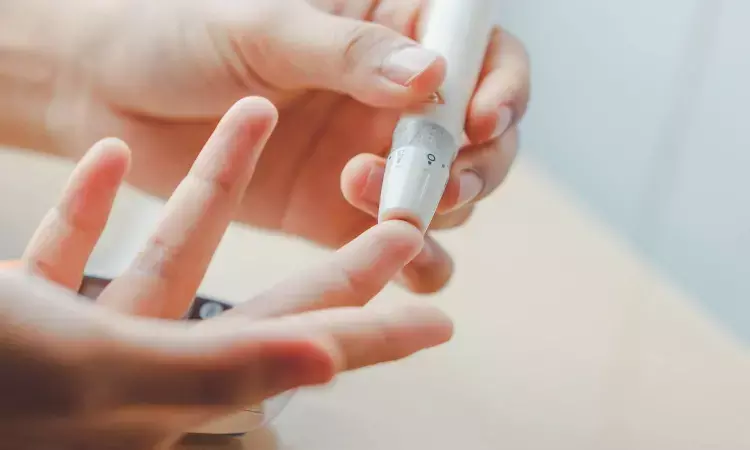- Home
- Medical news & Guidelines
- Anesthesiology
- Cardiology and CTVS
- Critical Care
- Dentistry
- Dermatology
- Diabetes and Endocrinology
- ENT
- Gastroenterology
- Medicine
- Nephrology
- Neurology
- Obstretics-Gynaecology
- Oncology
- Ophthalmology
- Orthopaedics
- Pediatrics-Neonatology
- Psychiatry
- Pulmonology
- Radiology
- Surgery
- Urology
- Laboratory Medicine
- Diet
- Nursing
- Paramedical
- Physiotherapy
- Health news
- Fact Check
- Bone Health Fact Check
- Brain Health Fact Check
- Cancer Related Fact Check
- Child Care Fact Check
- Dental and oral health fact check
- Diabetes and metabolic health fact check
- Diet and Nutrition Fact Check
- Eye and ENT Care Fact Check
- Fitness fact check
- Gut health fact check
- Heart health fact check
- Kidney health fact check
- Medical education fact check
- Men's health fact check
- Respiratory fact check
- Skin and hair care fact check
- Vaccine and Immunization fact check
- Women's health fact check
- AYUSH
- State News
- Andaman and Nicobar Islands
- Andhra Pradesh
- Arunachal Pradesh
- Assam
- Bihar
- Chandigarh
- Chattisgarh
- Dadra and Nagar Haveli
- Daman and Diu
- Delhi
- Goa
- Gujarat
- Haryana
- Himachal Pradesh
- Jammu & Kashmir
- Jharkhand
- Karnataka
- Kerala
- Ladakh
- Lakshadweep
- Madhya Pradesh
- Maharashtra
- Manipur
- Meghalaya
- Mizoram
- Nagaland
- Odisha
- Puducherry
- Punjab
- Rajasthan
- Sikkim
- Tamil Nadu
- Telangana
- Tripura
- Uttar Pradesh
- Uttrakhand
- West Bengal
- Medical Education
- Industry
Stress Hyperglycemia Ratio and Hypertension Closely Associated with Stroke Risk: Study

A new study published in the BMC Cardiovascular Diabetology found the importance of a novel metabolic marker, the stress hyperglycemia ratio (SHR), in predicting stroke risk-especially when combined with hypertension.
The study used data from the China Health and Retirement Longitudinal Study (CHARLS), followed 9,682 stroke-free participants aged 45 years and older from 2011 through 2020. This research calculated SHR using 2 indicators, the fasting blood glucose and glycated hemoglobin (HbA1c), to integrate both short-term stress-induced changes and long-term glycemic levels.
The participants were divided into 4 groups based on whether they had high or low SHR and whether they had hypertension. Over a median follow-up of 8.43 years, covering more than 81,000 person-years, the study documented 764 new stroke cases. This translated to an incidence rate of 9.36 strokes per 1,000 person-years.
The individuals with both high SHR and hypertension faced the highest risk of stroke, with a hazard ratio of 2.94 when compared to the individuals with low SHR and no hypertension. Even when considered separately, both SHR and hypertension independently increased the risk of stroke.
The risk escalated progressively from having neither risk factor, to one of the two, and peaked in individuals with both. The subgroup analyses showed that this pattern held true across both men and women, as well as across different age categories.
To test the predictive strength of SHR, the team performed a receiver operating characteristic (ROC) curve analysis. While hypertension alone is a known predictor of stroke, adding SHR significantly improved the ability to discriminate who was at higher risk. The combined model achieved an area under the curve (AUC) of 0.653 which suggested better performance than traditional risk factors alone.
The findings suggest that SHR reflects both acute stress responses and chronic glucose imbalances, making it a more comprehensive indicator of metabolic stress than fasting glucose or HbA1c alone.
Overall, this research suggests that measuring SHR along with blood pressure screening could improve stroke risk assessment tools, particularly in populations already burdened by hypertension. This integrated approach may open the door to earlier interventions and more targeted prevention strategies, ultimately reducing the global stroke burden.
Reference:
He, Y., Cao, Y., Xiang, R., & Wang, F. (2025). Predictive value and robustness of the stress hyperglycemia ratio combined with hypertension for stroke risk: evidence from the CHARLS cohort. Cardiovascular Diabetology, 24(1), 336. https://doi.org/10.1186/s12933-025-02898-z
Neuroscience Masters graduate
Jacinthlyn Sylvia, a Neuroscience Master's graduate from Chennai has worked extensively in deciphering the neurobiology of cognition and motor control in aging. She also has spread-out exposure to Neurosurgery from her Bachelor’s. She is currently involved in active Neuro-Oncology research. She is an upcoming neuroscientist with a fiery passion for writing. Her news cover at Medical Dialogues feature recent discoveries and updates from the healthcare and biomedical research fields. She can be reached at editorial@medicaldialogues.in
Dr Kamal Kant Kohli-MBBS, DTCD- a chest specialist with more than 30 years of practice and a flair for writing clinical articles, Dr Kamal Kant Kohli joined Medical Dialogues as a Chief Editor of Medical News. Besides writing articles, as an editor, he proofreads and verifies all the medical content published on Medical Dialogues including those coming from journals, studies,medical conferences,guidelines etc. Email: drkohli@medicaldialogues.in. Contact no. 011-43720751


